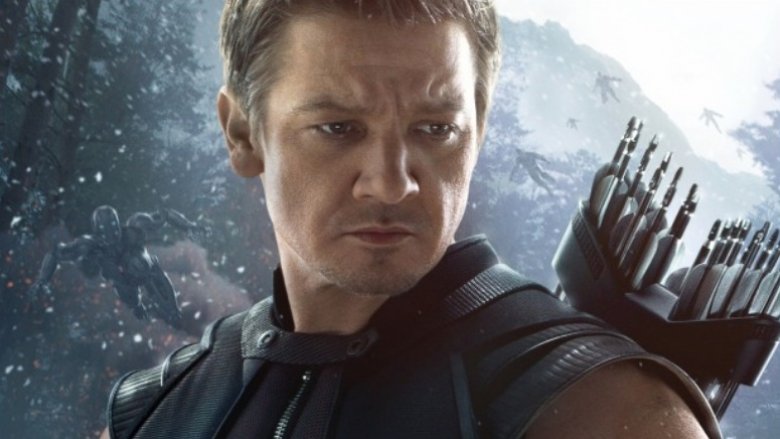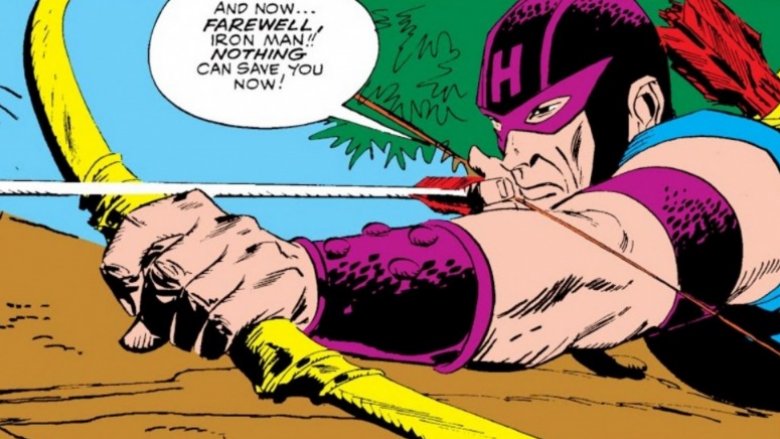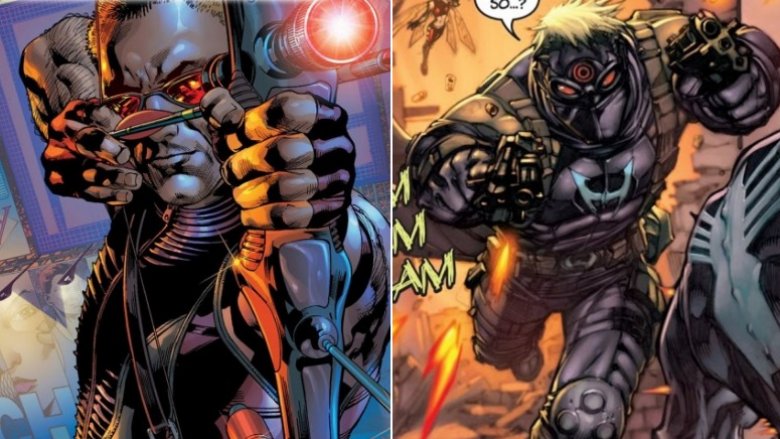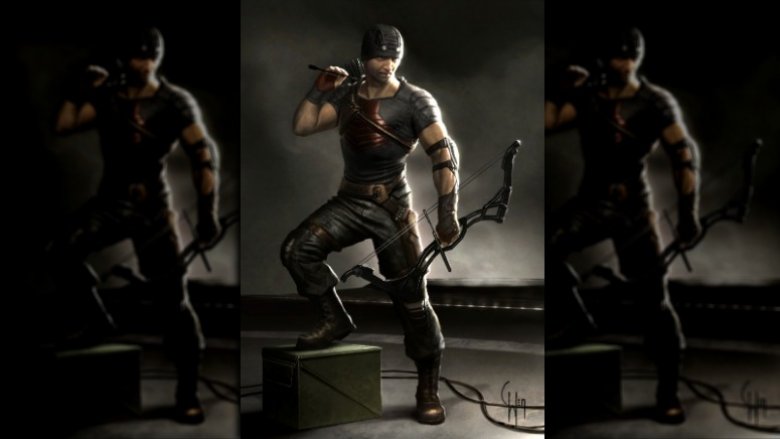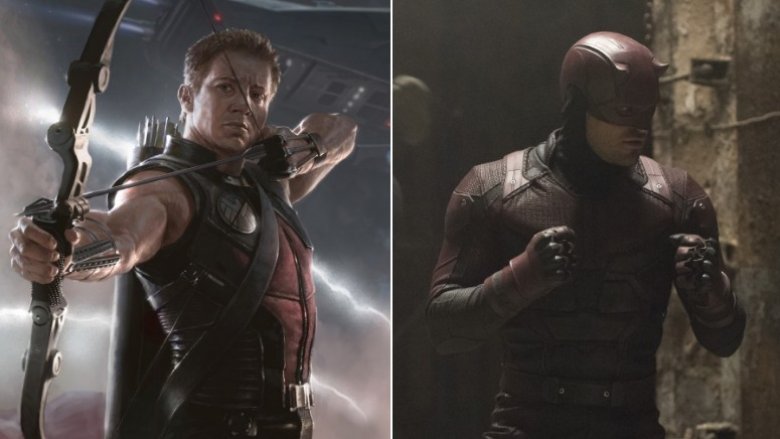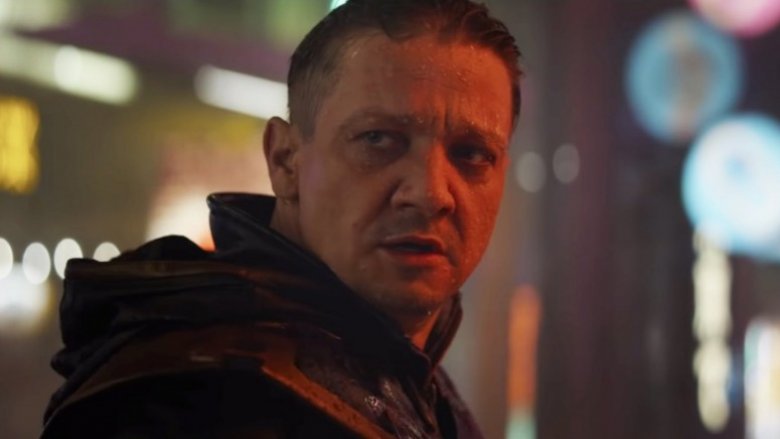What Hawkeye Almost Looked Like In The MCU - Exclusive
Somehow, in a movie filled with larger-than-life, super-powered characters with adventure-filled, dramatic backstories, the totally regular dude with the bow and arrow still managed to become a fan favorite. It's pretty unlikely, when you think about it, that Clint Barton — better known by his superheroic alias of Hawkeye — would ever become so popular. But that's exactly what happened, and his return to the Marvel Cinematic Universe in Avengers: Endgame wound up generating tons of hype among the MCU's most ardent fans. Who cares about that whole "beat Thanos and resurrect half the universe's population" thing? Hawkeye's back, and he's got a new outfit!
Indeed, sometimes what a character is wearing in a movie is nearly as important as what the character actually does, and Hawkeye's no different. That's why it's interesting to imagine an alternate universe where Hawkeye had a different look on the big screen. For that thought exercise, we turn to Looper's exclusive interview with Charlie Wen, former head of visual development at Marvel Studios, who dropped some knowledge about the direction he and his team almost went when designing Hawkeye's threads.
Arrows versus armor
Believe it or not, Hawkeye originally got started in the masked adventuring game not because he wanted to make a difference in the world, not because of some kind of trauma that forced him into a life of archery, and not because he was bitten by a radioactive arrow. No, it was because he was working at a carnival sideshow and got jealous of how much people loved Iron Man. That's seriously it.
Now, with that kind of origin story — one in which a guy decides to be a costumed crimefighter purely out of spite — it's no surprise that the first version of the outfit he put together leaves a lot to be desired. While we're not trying to put down the design work of legendary Marvel artist Don Heck, the first rendition of Hawkeye's uniform is kind of all over the place. The outfit's got some medieval stylings, most likely as a contrast to Iron Man's high-tech suit of armor. But overall it's just kind of a mishmash of straps, bands, cowls, cuffs, and colors. And don't forget the H on his forehead — H for Hawkeye, of course!
While Hawkeye's look evolved over the years in many different ways, this original outfit eventually morphed into the more or less classic blue and purple outfit that the character is best known for. But let's be real: neither of these outfits ever had any hope of making it onto the big screen in the Marvel Cinematic Universe.
The Ultimate costume change
Even though Hawkeye's look changed over the years in the mainstream Marvel Comics Universe, one of the most influential changes occured in 2002, when Mark Millar and Bryan Hitch launched The Ultimates — sort of a modern version of the original Avengers team. Ultimate Hawkeye made his debut in the seventh and eighth issues, and while he's kind of light on personality, he's heavy on the action.
This version of Clint Barton, shown on the left side above, is a highly trained government operative. Hawkeye's origins involve neither the carnival nor Iron Man envy, and his new outfit reflects that streamlined and modernized change. Ultimate Hawkeye sports a sort of tactical espionage outfit and a pair of shades. There isn't anything particularly iconic or even memorable about it, but it does look much more realistic... and far less ridiculous than his traditional comic book purple.
That realistic take was more or less undone by the time the third Ultimates series debuted, featuring another costume change for Hawkeye. This one wasn't designed by Hitch, but rather by Battle Chasers artist Joe Madureira, who has a far more bombastic, anime-influenced style. Madureira's particular look included a purple mask with a pair of built-in red lenses that definitely felt like a throwback to the comic books of the '90s — which, unsurprisingly, didn't factor much into Wen's designs for the movies.
Getting real
Charlie Wen explained that when designing Hawkeye's cinematic appearances in Thor and Avengers, the art from the first two Ultimates runs, penciled by Bryan Hitch, served as an overall inspiration.
"We definitely referenced a lot of Bryan Hitch's work on The Ultimates," he explained. "The Ultimates was such a great impact on modernizing the comic book side of things [...] bringing it into something that we could leverage and feel. It was very palpable."
Wen went on to explain that the work he was doing for Avengers was a departure from the comic books we all grew up reading — even though the movies of the MCU have been lauded for their fealty to the source material.
"The kind of stories that I was telling was definitely a lot more grown up stories, right? Not the kind that we grew up with. So were the costumes, it was a little bit more gritty, a little bit more earthy," he said. "In Avengers, I was creating the Hawkeye for something that was more urban. I was envisioning him to be somebody that wasn't ... it's not like he was in this whole superhero world at all. He's a normal guy, right?"
That's why, according to Wen's take on the character, this normal guy didn't have a flashy or elaborate getup, and even had a pair of tactical-looking lenses at the ready, presumably to help him make the shot.
Bowman without fear
About a year after The Avengers hit theaters, another long-awaited superhero project started to gather steam: the Netflix series Daredevil, starring Charlie Cox. And while Wen didn't actually work on the Daredevil project — Marvel's television and film arms were pretty separate at this point in history — it seems that great minds really do think alike. According to Wen, he thought that his approach to Clint Barton's cinematic design managed to find its way onscreen anyway, just in the form of Netflix's take on Matt Murdock.
"In a way, maybe I was envisioning a little more of what eventually became Daredevil, for the Netflix series much later," he said. "That's kind of the feel that I was thinking about when I was doing that version of Hawkeye.
Crucial to Wen's approach, he said, were the qualities that definitively make Hawkeye less "super" and more "human":
"I wanted to make sure that I also portrayed a version that was more urban and more about a family guy. Who is Hawkeye as a person?"
That vision of the character eventually appeared along with Hawkeye's wife and kids by the time Avengers: Age of Ultron hit theaters in 2015. Funnily enough, that movie featured a costume design that started hewing even more closely to Hawkeye's classic, non-Ultimate comic book design.
Hawkeye's latest identity crisis
Throughout the character's existence, not only has he changed outfits with some regularity, he's even changed identities. In the '70s, he got mixed up with Hank Pym's size-changing gizmos and took on the identity of Goliath. And in the 2000s, Hawkeye took on yet another super-alias: Ronin, a black-clad martial artist who's as apt to use a pair of nunchucks as he is a bow and arrow.
Meanwhile, the MCU's version of Hawkeye seems to have been fully reinvented yet again. The trailers for 2019's Avengers: Endgame revealed that Clint Barton seems to have shed his Hawkeye identity in favor of what appears to be the cinematic debut of the Ronin outfit. While we don't yet have much information about what may have prompted the character's latest change of clothes, it goes without saying that Wen's work designing a grounded, realistic version of Clint Barton undoubtedly had a huge influence on the Hawkeye we've grown to know and love.
You can follow Charlie Wen on Instagram, Twitter, and Facebook.
